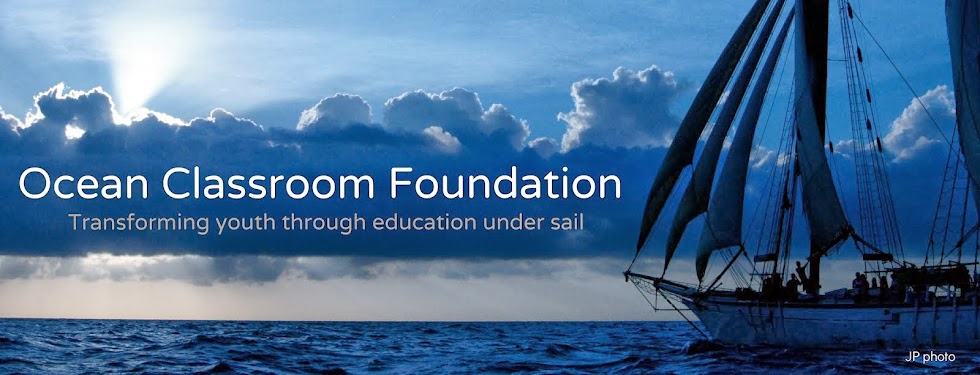Grand Cayman Island
>> Thursday, March 19, 2009

Our stop to Grand Cayman has epitomized the excitement of the unknowns of a sailing adventure. All we have to do is take advantage of the unique, exciting and genuine opportunities along the way, which is certainly what we are in the midst of doing right now. Situated at the edge of the deepest part of the Caribbean Sea, the Cayman Trench, this low-lying, limestone island is surrounded by coral reefs, teaming with life in crystal clear turquoise Caribbean waters.
We have paddled on kayaks through the red and black mangrove forests learning about their important ecological niches; had classes on the white coral sandy beaches; snorkeled in a majestic coral reef community with sea turtles; barbequed on the beach; and saw octopi, tarpon, a giant green moral eel, star fish, sea urchins, coral banded shrimp, sleeping squirrel fish and spiny lobster on our night snorkel. Students have even managed to complete a navigation seamanship quiz, prepare for their upcoming marine science test covering ocean and atmospheric circulation, learn about the history of the Caymanian turtle fishery and write a creative historical short story based in the DR. Never a dull moment.
So what do the students have to say about all of this?
In response to the question, “What was your favorite thing about yesterday,“ here is what each of the students had to say:
“Going snorkeling along Eden Rock and seeing the barracuda, jellyfish and school of sergeant majors following me. That was cool.” -Sally Nyguen
“Doin’ the cook out. I like being a grill meister. And seeing the turtle and the huge barracuda that Lucas and I saw.” -Anthony Merrill
“The experience of swimming with a sea turtle. That was cool.”
-Lucas George
“The octopi. By far.” -Pearce Flynn
“Probably the night dive. Seeing the eel.” -Alyssa Reetz
“Favorite thing…the night snorkeling. The octopus was really cool. It was just more exciting the reef during the day time.” -Cody Barry
“I liked kayaking, but I also like the octopus and the eel.” -Tristan Pavlik
“I thought seeing the eel and the octopus in the night snorkel was really cool.”
-Emily Burke
“About yesterday? I guess kayaking in the mangroves. So beautiful and nothing I have ever seen before. But hanging in the water after class on the beach was quintessentially fun.” -Mackenzie Gassett
“Kayaking. I love kayaking. And the starfish” -Chandler Neale
“Like one specific thing? Kayaking was a lot of fun and then from there…probably the BBQ and night dive in sequence. I really enjoyed swimming at night. Seeing the eel, octopus, and lobsters. Just really thought it was incredible. Mainly I just really enjoyed the entire day.” -Logan Wellborn
“The kayaking was cool. Really cool. But I liked the night diving, to swim around and see fish with lights. I got to see a tarpon at night and that was cool.”
-Christo Milholland
“Just being able to sit out on fossilized coral and enjoy the sunset while eating dinner.”
-Mariclaire Joseph
“Yesterday was my favorite day out of the whole entire trip. We were just like a family…we learned a lot. I loved kayaking and hopping off the boats and swimming.”
-Sari Weiss
“I liked the kayaking.” -Josephine Miller
“I liked the sea turtle. I definitely liked the sea turtle…the way it swam and following it.” -Annie Wilcox
“Probably the night snorkel. The tarpon.” -Hanna Jovine
“The BBQ. Just hanging out on the beach and talking to a an older Caymanian who worked on a lumber boat that went that all over the world.” -Anton Landauer
“The kayaking. At the end we were going really fast.” -Jamaine Gooding
“Definitely going through the mangrove canals.” -Madeline Owen
Another successful day of school.
-Christine Honan (Head Educator)






